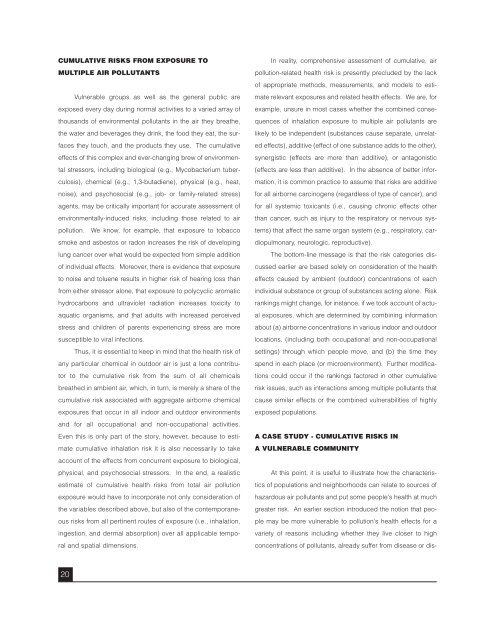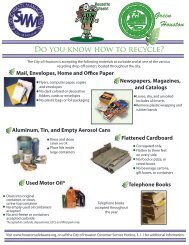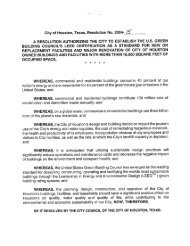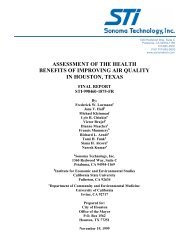A Closer Look at Air Pollution in Houston: - Green Houston
A Closer Look at Air Pollution in Houston: - Green Houston
A Closer Look at Air Pollution in Houston: - Green Houston
You also want an ePaper? Increase the reach of your titles
YUMPU automatically turns print PDFs into web optimized ePapers that Google loves.
CUMULATIVE RISKS FROM EXPOSURE TOMULTIPLE AIR POLLUTANTSVulnerable groups as well as the general public areexposed every day dur<strong>in</strong>g normal activities to a varied array ofthousands of environmental pollutants <strong>in</strong> the air they bre<strong>at</strong>he,the w<strong>at</strong>er and beverages they dr<strong>in</strong>k, the food they e<strong>at</strong>, the surfacesthey touch, and the products they use. The cumul<strong>at</strong>iveeffects of this complex and ever-chang<strong>in</strong>g brew of environmentalstressors, <strong>in</strong>clud<strong>in</strong>g biological (e.g., Mycobacterium tuberculosis),chemical (e.g., 1,3-butadiene), physical (e.g., he<strong>at</strong>,noise), and psychosocial (e.g., job- or family-rel<strong>at</strong>ed stress)agents, may be critically important for accur<strong>at</strong>e assessment ofenvironmentally-<strong>in</strong>duced risks, <strong>in</strong>clud<strong>in</strong>g those rel<strong>at</strong>ed to airpollution. We know, for example, th<strong>at</strong> exposure to tobaccosmoke and asbestos or radon <strong>in</strong>creases the risk of develop<strong>in</strong>glung cancer over wh<strong>at</strong> would be expected from simple additionof <strong>in</strong>dividual effects. Moreover, there is evidence th<strong>at</strong> exposureto noise and toluene results <strong>in</strong> higher risk of hear<strong>in</strong>g loss thanfrom either stressor alone, th<strong>at</strong> exposure to polycyclic arom<strong>at</strong>ichydrocarbons and ultraviolet radi<strong>at</strong>ion <strong>in</strong>creases toxicity toaqu<strong>at</strong>ic organisms, and th<strong>at</strong> adults with <strong>in</strong>creased perceivedstress and children of parents experienc<strong>in</strong>g stress are moresusceptible to viral <strong>in</strong>fections.Thus, it is essential to keep <strong>in</strong> m<strong>in</strong>d th<strong>at</strong> the health risk ofany particular chemical <strong>in</strong> outdoor air is just a lone contributorto the cumul<strong>at</strong>ive risk from the sum of all chemicalsbre<strong>at</strong>hed <strong>in</strong> ambient air, which, <strong>in</strong> turn, is merely a share of thecumul<strong>at</strong>ive risk associ<strong>at</strong>ed with aggreg<strong>at</strong>e airborne chemicalexposures th<strong>at</strong> occur <strong>in</strong> all <strong>in</strong>door and outdoor environmentsand for all occup<strong>at</strong>ional and non-occup<strong>at</strong>ional activities.Even this is only part of the story, however, because to estim<strong>at</strong>ecumul<strong>at</strong>ive <strong>in</strong>hal<strong>at</strong>ion risk it is also necessarily to takeaccount of the effects from concurrent exposure to biological,physical, and psychosocial stressors. In the end, a realisticestim<strong>at</strong>e of cumul<strong>at</strong>ive health risks from total air pollutionexposure would have to <strong>in</strong>corpor<strong>at</strong>e not only consider<strong>at</strong>ion ofthe variables described above, but also of the contemporaneousrisks from all pert<strong>in</strong>ent routes of exposure (i.e., <strong>in</strong>hal<strong>at</strong>ion,<strong>in</strong>gestion, and dermal absorption) over all applicable temporaland sp<strong>at</strong>ial dimensions.In reality, comprehensive assessment of cumul<strong>at</strong>ive, airpollution-rel<strong>at</strong>ed health risk is presently precluded by the lackof appropri<strong>at</strong>e methods, measurements, and models to estim<strong>at</strong>erelevant exposures and rel<strong>at</strong>ed health effects. We are, forexample, unsure <strong>in</strong> most cases whether the comb<strong>in</strong>ed consequencesof <strong>in</strong>hal<strong>at</strong>ion exposure to multiple air pollutants arelikely to be <strong>in</strong>dependent (substances cause separ<strong>at</strong>e, unrel<strong>at</strong>edeffects), additive (effect of one substance adds to the other),synergistic (effects are more than additive), or antagonistic(effects are less than additive). In the absence of better <strong>in</strong>form<strong>at</strong>ion,it is common practice to assume th<strong>at</strong> risks are additivefor all airborne carc<strong>in</strong>ogens (regardless of type of cancer), andfor all systemic toxicants (i.e., caus<strong>in</strong>g chronic effects otherthan cancer, such as <strong>in</strong>jury to the respir<strong>at</strong>ory or nervous systems)th<strong>at</strong> affect the same organ system (e.g., respir<strong>at</strong>ory, cardiopulmonary,neurologic, reproductive).The bottom-l<strong>in</strong>e message is th<strong>at</strong> the risk c<strong>at</strong>egories discussedearlier are based solely on consider<strong>at</strong>ion of the healtheffects caused by ambient (outdoor) concentr<strong>at</strong>ions of each<strong>in</strong>dividual substance or group of substances act<strong>in</strong>g alone. Riskrank<strong>in</strong>gs might change, for <strong>in</strong>stance, if we took account of actualexposures, which are determ<strong>in</strong>ed by comb<strong>in</strong><strong>in</strong>g <strong>in</strong>form<strong>at</strong>ionabout (a) airborne concentr<strong>at</strong>ions <strong>in</strong> various <strong>in</strong>door and outdoorloc<strong>at</strong>ions, (<strong>in</strong>clud<strong>in</strong>g both occup<strong>at</strong>ional and non-occup<strong>at</strong>ionalsett<strong>in</strong>gs) through which people move, and (b) the time theyspend <strong>in</strong> each place (or microenvironment). Further modific<strong>at</strong>ionscould occur if the rank<strong>in</strong>gs factored <strong>in</strong> other cumul<strong>at</strong>iverisk issues, such as <strong>in</strong>teractions among multiple pollutants th<strong>at</strong>cause similar effects or the comb<strong>in</strong>ed vulnerabilities of highlyexposed popul<strong>at</strong>ions.A CASE STUDY - CUMULATIVE RISKS INA VULNERABLE COMMUNITYAt this po<strong>in</strong>t, it is useful to illustr<strong>at</strong>e how the characteristicsof popul<strong>at</strong>ions and neighborhoods can rel<strong>at</strong>e to sources ofhazardous air pollutants and put some people's health <strong>at</strong> muchgre<strong>at</strong>er risk. An earlier section <strong>in</strong>troduced the notion th<strong>at</strong> peoplemay be more vulnerable to pollution's health effects for avariety of reasons <strong>in</strong>clud<strong>in</strong>g whether they live closer to highconcentr<strong>at</strong>ions of pollutants, already suffer from disease or dis-20







